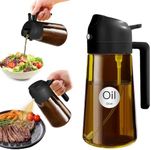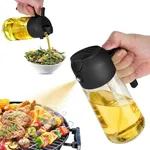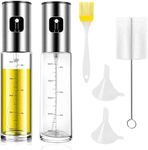Buying Guide for the Best Olive Oil Sprayers
Choosing the right olive oil sprayer can make a big difference in your cooking experience, helping you control the amount of oil you use and ensuring even coverage on your food or pans. When shopping for an olive oil sprayer, it's important to consider how you'll use it—whether for salads, grilling, baking, or general cooking. Understanding the key features will help you pick a sprayer that fits your needs and is easy to use and maintain.MaterialThe material of an olive oil sprayer affects its durability, safety, and ease of cleaning. Common materials include glass, stainless steel, and plastic. Glass is non-reactive and lets you see how much oil is left, but it can break if dropped. Stainless steel is sturdy and often looks sleek, but you can't see the oil level. Plastic is lightweight and less likely to break, but may absorb odors or stain over time. If you want something durable and stylish, stainless steel is a good choice. If you prefer to monitor oil levels easily, glass might be better. For outdoor or travel use, plastic could be more practical.
Spray MechanismThe spray mechanism determines how the oil is dispensed—either as a fine mist or a stream. Some sprayers use a pump action, while others use a trigger or pressurized system. A fine mist is ideal for evenly coating salads or pans with minimal oil, while a stream is better for pouring or drizzling. If you want to use less oil and get even coverage, look for a sprayer that produces a consistent mist. If you need versatility for both misting and pouring, consider a model that offers adjustable spray settings.
CapacityCapacity refers to how much oil the sprayer can hold, usually measured in ounces or milliliters. Smaller capacities (around 100ml or less) are compact and easy to handle, making them suitable for occasional use or small kitchens. Larger capacities (200ml or more) mean fewer refills, which is convenient for frequent cooking or larger households. Choose a size that matches how often you cook and how much oil you typically use, keeping in mind that oil can go rancid if stored too long.
Ease of CleaningEase of cleaning is important because oil can leave residue and clog the sprayer over time. Some sprayers are dishwasher safe, while others need to be washed by hand. Models with wide openings are easier to fill and clean, while those with narrow necks may require a brush. If you want low maintenance, look for a sprayer that can be easily disassembled and cleaned, and check if it's dishwasher safe for added convenience.
Leak-Proof DesignA leak-proof design prevents oil from spilling or leaking, which keeps your kitchen clean and avoids waste. Some sprayers have special seals or locking mechanisms to prevent leaks. If you plan to store the sprayer in a cabinet or take it on the go, a leak-proof model is especially important. Check for user-friendly designs that seal tightly and don't drip after spraying.


















